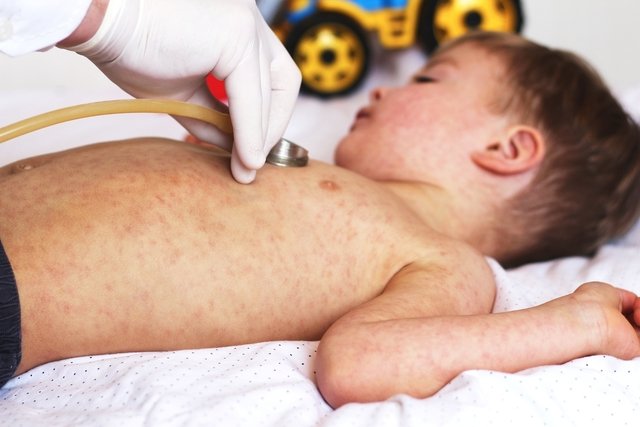Measles is a highly contagious disease caused by a virus that leads to the appearance of some symptoms such as fever, persistent cough, runny nose, conjunctivitis, small reddish spots that start near the scalp and then descend, spreading throughout the body and that they do not itch or cause discomfort.
Measles treatment is done to alleviate symptoms, because the body is capable of eliminating the virus naturally, with only rest, hydration and a light diet being recommended. However, it is important that the doctor is consulted so that guidance can be given, especially in the case of children, who may need vitamin A supplementation.
The measles vaccine is the best way to prevent the disease and is part of the basic childhood vaccination schedule, with the first dose recommended at 12 months. However, if the vaccine was not given during childhood, it is possible to take the vaccine at any stage of life, in which case only one dose is recommended.

Main symptoms
The main symptoms of measles are:
- Reddish spots on the skin that first appear on the face and then spread towards the feet, and which do not itch;
- Rounded white spots on the inside of the cheek;
- High fever, above 38.5ºC;
- Cough with phlegm;
- Conjunctivitis;
- Hypersensitivity to light;
- Running nose;
- Loss of appetite;
- There may be headache, abdominal pain, vomiting, diarrhea and muscle pain.
Measles symptoms can appear 8 to 12 days after contact with the virus, and it is important that treatment is started soon after to prevent complications. See more about measles symptoms.
Read too: 8 main symptoms of measles
Online symptom test
To find out if you have measles, select the symptoms you present in the test below:
The symptom test is only a guidance tool and does not serve as a diagnosis and does not replace consultation with an infectious disease specialist or general practitioner.
How the diagnosis is made
The diagnosis of measles is made by the doctor based on the evaluation of the signs and symptoms presented by the person. However, to confirm the infection and rule out other diseases that may present similar symptoms, it is necessary to perform a laboratory test.
The laboratory diagnosis of measles consists of carrying out a serological test, normally using the ELISA technique, to identify specific antibodies against the virus (IgG and IgM) or antigens, which can be done by analyzing a sample of urine, blood , cerebrospinal fluid or oral and nasopharyngeal secretions.
Read too: ELISA test: what it is, what it is for, how it is done (and results)
Furthermore, the diagnosis can also be carried out using the PCR technique, which aims to identify the presence of the virus in the body, as well as its quantity, and this test can be carried out by analyzing urine or oral and nasopharyngeal secretions.
Make an appointment with your nearest doctor using the following tool to investigate the possibility of measles:
Taking care of your health has never been easier!
How transmission happens
Measles is spread mainly through the air, when an infected person coughs or sneezes, as the droplets released may contain viral particles capable of causing illness.
Furthermore, the virus can remain on surfaces for up to 2 hours, so contact with contaminated surfaces could also be considered a route of measles transmission.
The period in which there is a greater chance of transmission of the virus is 2 days before and after the appearance of the red spots on the skin.
Measles treatment
Measles treatment consists of reducing symptoms through rest, adequate hydration and the use of medications to reduce fever. Furthermore, the World Health Organization (WHO) also recommends vitamin A supplementation for all children diagnosed with measles, which should be done according to the child’s age and following the guidance of the pediatrician and/or nutritionist.
Normally, a person with measles recovers completely, achieving cure in about 10 days after the onset of symptoms. But the use of antibiotics may be indicated when there is evidence of an associated bacterial infection, if the person also has an ear infection or pneumonia, as these are common complications of measles. See more details on measles treatment.
Possible complications
In most cases, measles symptoms disappear without leaving any type of sequelae. However, in the case of people with a weakened immune system, there is a greater chance of developing complications, such as airway obstruction, pneumonia, encephalitis, ear infection, blindness and severe diarrhea, which can result in dehydration.
Therefore, to prevent the development of complications, it is important that the general practitioner or infectious disease specialist is consulted as soon as the first signs and symptoms of measles appear.
How to prevent
The best way to prevent measles is vaccination against the disease, the first dose of which is recommended at 12 months. However, there are some simple precautions that can also help, such as:
- Wash your hands frequently, especially after being in contact with sick people;
- Avoid touching your eyes, nose or mouth if your hands are not clean;
- Avoid being in closed places with lots of people;
- Do not have direct contact with sick people, such as kissing, hugging or sharing eating utensils.
Isolating the patient is another way to prevent the spread of the disease, although only vaccination is really effective. Therefore, if a person is diagnosed with measles, everyone who has close contact with them, such as parents and siblings, must be vaccinated, if they have not already been vaccinated, and the patient must stay at home, rest, without going to school or work, so as not to contaminate others.
measles vaccine
The measles vaccine is generally given free of charge at 12 months of age, with a booster between 15 and 24 months. In the case of the tetraviral vaccine, two doses are recommended, the first being administered from 12 months onwards. There are 2 main ways to get the measles vaccine, the exclusive vaccine or the combined ones:
- Triple-viral vaccine: against measles, mumps and rubella;
- Tetraviral vaccine: which also protects against chicken pox.
Anyone can be vaccinated, as long as they have not yet had the vaccine, but the measles vaccine can also be administered to people who are exposed to the virus, as happens when parents have not been vaccinated and have a child with measles. But, in this case, for it to be effective, the person must be vaccinated within 3 days of the appearance of symptoms in the person with whom they had contact. Find out more about the measles vaccine.

Sign up for our newsletter and stay up to date with exclusive news
that can transform your routine!
Warning: Undefined array key "title" in /home/storelat/public_html/wp-content/plugins/link-whisper-premium/templates/frontend/related-posts.php on line 12
Warning: Undefined array key "title_tag" in /home/storelat/public_html/wp-content/plugins/link-whisper-premium/templates/frontend/related-posts.php on line 13



